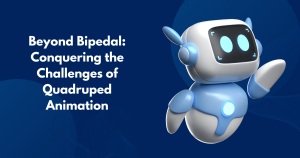The doubtful quadruped cramped many animators’ journeys, an issue of modern animation that has been called Quisque at best and quizzed at worst. Instead of making a clever joke, let’s discuss how to set up quadcopters for animation.
Beyond Bipedal: Conquering the Challenges of Quadruped Animation
More inquiries than any other topic concern creating, rigging, and animating characters, and quadrupeds are among the most common topics.
We are all aware of the motion design industry’s broad range and unpredictable nature. Anything thrown at them should be manageable for a skilled motion designer. That’s one of the reasons character animation is essential for motion designers to learn. You never know when a character might need to be brought to life.
However, you never know what sort of character that could be. Although humans will most likely be involved, other possibilities include dogs, donkeys, and dinosaurs. Not to mention the countless options for creatures other than quadrupeds, like fish, insects, and birds. We’ll steer clear of that pile of worms, which you may also need to animate!
For a good reason: most character animation curricula start with the bipedal humanoid. Since you are one of them, it is also the most familiar and frequent character you will likely encounter. Naturally, there are several additional creatures in the world that you might be asked to bring to life.

Naturally, I need more time or room to discuss every animal. Still, it would be interesting to discuss the quadruped briefly, arguably the second most prevalent sort of character after humans with bipeds that you might come across.
Quadruped versus Biped Locomotion
To ensure that we are both on the same page, let’s begin by clarifying our words. The terms “quadrupeds” and “bipeds” refer to an animal’s mode of locomotion rather than any particular taxonomic classification, such as a genus or species.
Let’s analyze it now:
- An organism classified as bipedal uses its two back legs or limbs to move about on land.
- Humans are one example, but there are also kangaroos, some kinds of dinosaurs, and birds, which are feathered, bipedal dinosaurs!
- A creature that uses four limbs or legs for terrestrial locomotion is said to be quadruple.
- Most quadrupeds, but not all, are vertebrate animals, such as dragons, dogs, cats, cattle, and reptiles.
Pay attention to the feet.
When studying comparative anatomy, you’ll notice a few differences in the skeletal structures of vertebrates’ bodies. The skull, ribs, pelvic region, and spine, which include the neck and possibly the tail, are all present. And they’re all utilized and organized similarly.
The limbs, and especially the feet or paws, are where things become more specialized. Although the bones are essentially the same as what we know from comparative anatomy, there are three slightly distinct categories in which these bones are used.
PLANTIGRADES
These creatures walk on two or four legs, flat on the ground, using their hand, foot, or paw bones (carpal, metacarpal, tarsal, and metatarsal bones). Among the examples are human primates, bears, mice, rabbits, kangaroos, and other animals. The bear animation below illustrates how each step causes the “palms” of the hands and paws and the bottoms of the feet, from the toes to the heel, to rest on the ground.
digitigrades
These are the animals whose wrists and ankles are raised above the floor when they walk on the phalanges, the bones of their fingers or toes. Examples include most mammals, dinosaurs, and non-hooved vertebrates like dogs and cats. In this clip, note how just the dog’s fingers, toes, and phalanges touch the ground. The long bones extending up from the toes on the back legs are the foot (most digitigrades and ungulates have very long feet), and the first joint above your toes is the ankle. The wrists are the first joints, just above the toes on the front legs.
ANGULATES OR UNGULIGRADES
These creatures use their hooves to walk on the tips of their toes. All cattle, pigs, giraffes, deer, and elephants—referred to as “sub-ungulates”—are among the examples. As this horse gif illustrates, ungulates and digitigrades are similar in that they have off-the-ground wrists and ankles. The ungulates’ “hooves,” which are highly adapted, specialized, and stronger “toenails” or “fingernails,” allow them to walk on the points of their toes rather than having their toes, fingers, or phalanges flat on the ground. This is a very slight distinction between ungulates and digitigrades. Once more, take note of the rear legs’ extremely lengthy foot bones.
Comparing Anatomy and Design
While all this semi-scientific jargon is crucial to understanding the creatures we’re attempting to animate, it’s essential to remember that we sometimes only work with very accurate animal models.
Depending on the design we’re building, we must modify our rigging and animation choices as we stylize, exaggerate, and anthropomorphize different species. A cartoon dog, like Brian from Family Guy, is a bipedal plantigrade and must be rigged and animated accordingly. On the other hand, a natural dog is a quadrupedal digitigrade.
Animation and rigging problems
A thorough grasp of the anatomy, especially its skeletal anatomy, is essential if you are animating it with a rigged puppet.
If you are using After Effects, there are already prefabricated arm and leg “structures” for plantigrades (both bipedal and quadrupedal), digitigrades, and ungulates in the fantastic DuikBassel script for rigging and animation. These will all auto-rig correctly, giving you the necessary structure and motion.
The animator can create anatomically “correct” poses and movements for quadrupeds with great assistance from an adequately rigged puppet. However, a thorough understanding of the animal’s anatomy is essential, whether you are animating using a rig, creating your animation by hand, or utilizing another technique. Additionally, it would help if you conducted in-depth research on the creature’s movement and structure.
If you can’t convince an elephant to visit your studio, you can still find many video references of practically any beastie you can imagine online. Disney Studios was the first to bring live animals into the studio so that the artists could study their anatomy and movement.
To effectively tackle the task of creating, rigging, and animating quadruples, it is essential to have a thorough understanding of them. This is one of the most enjoyable and fulfilling parts of character animation. How fortunate are we to have a career that allows us to study aardvarks, lizards, or zebras for an afternoon? The next time you’re asked to bring one of these animals to life, this essay may make you feel more at ease dealing with quadrupeds.

